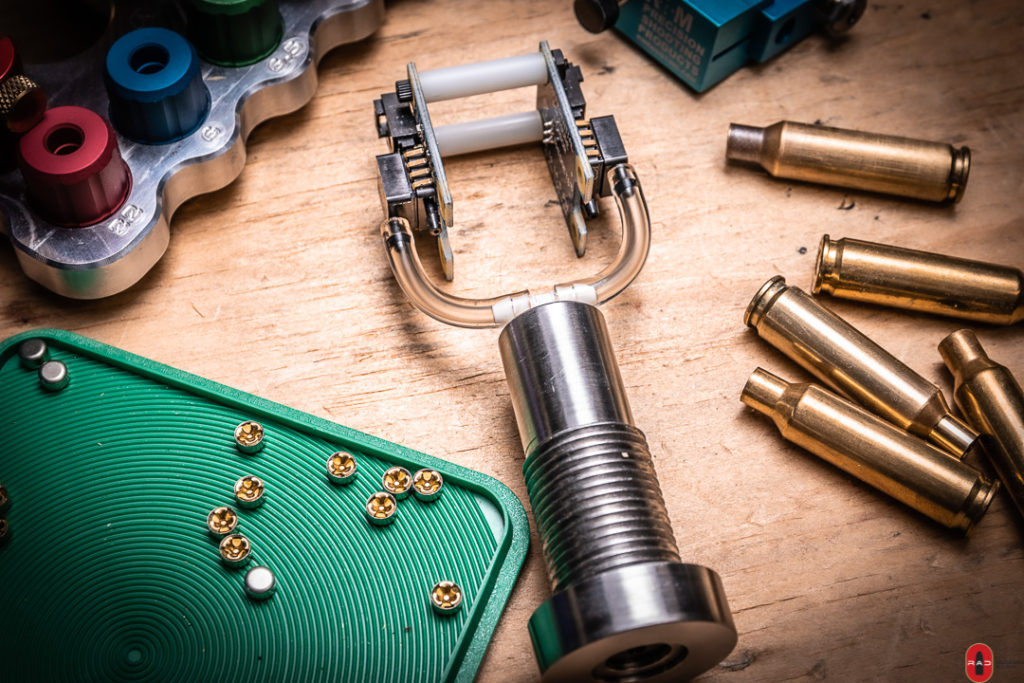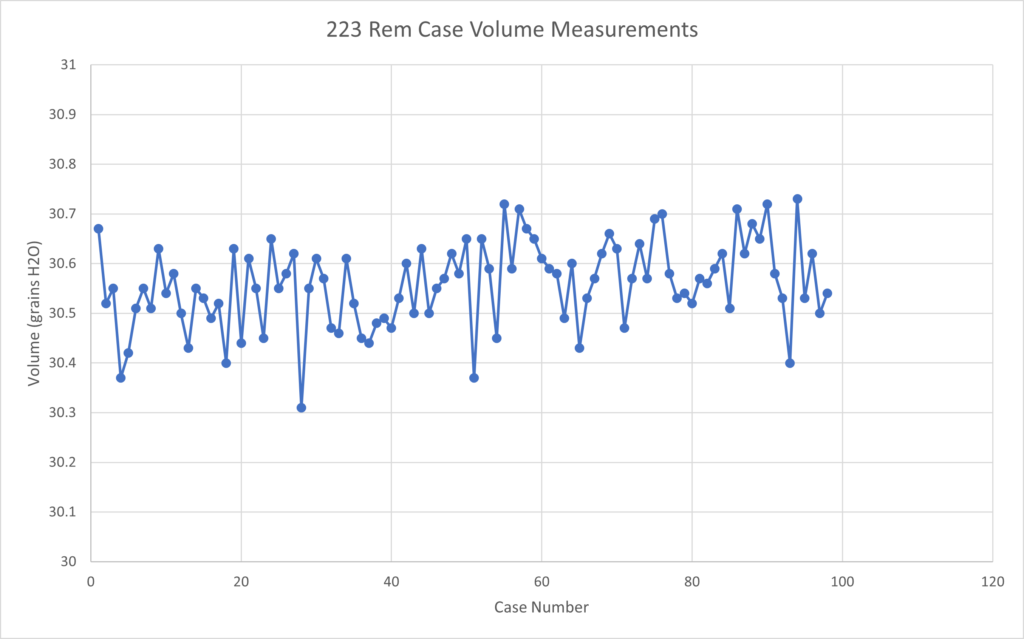
In this post I address the use cases for measuring case volume. Reloaders have gotten by for quite a while without measuring the volume of every case. Most reloaders never measure case volume. What are the reasons anyone would want to?
If you are interested in the Bison Armory Case Volumizer you can see them in our online store here.
In the past, measuring case volume was a slow task. Typically the reloader would weigh a case, fill it with water, then re-weigh the case to measure the weight of the water that filled the case. Obviously not the most desirable method. With the new Bison Armory case volumizer, the task is simplified to the point that it takes only minutes to accurately measure the volume of 100 or more cases.
Prior to this, there was not much point in discussing the reasons for measuring case volume. The cost in terms of time and effort were simply not worth the resulting information. Now that cases are easily measured with the Bison Case Volumizer (BCV), the question of why becomes interesting.
Checking for bad cases
Split case necks and other defects are real. Are you hunting? Shooting in a match? Going to a training class? The BCV easily detects any case with split neck or other compromise to its structure. A volumized case is one you can rely on.
Pushing the limits
Bison Armory does not advise pushing muzzle velocity to the limits, but we know some reloaders will do this. Suppose you are reloading all Winchester cases and a Starline case sneaks in. If you are pushing velocity to its maximum safe limits, a case with lower capacity than expected, like you might get from one from another brand sneaking into your batch unknown, could cause catastrophe. The BCV will detect these cases. In addition, suppose a new lot from the same manufacturer happens to be low. Manufacturing tolerances will vary somewhat even for the best manufacturers. The BCV when used properly and within its limitations, will alert the reloader to these sort of situations.
Long range accuracy
At 500 yards and beyond, variation in muzzle velocity starts to have a significant effect on accuracy. I shoot long range matches in F-Class and Service Rifle categories. Pushing the 223 Rem to 1000 yards is a lot of fun with the right bullets, but how much does variation in case volume affect long range accuracy? Quickload is a handy tool for cursory investigations into this question.
We can start with the common question of how much does variation in powder charge affect velocity and hence vertical dispersion at long range. For the 223 Rem with my personal load of 22.2 grains of H4895 in a Winchester case behind a 90 grain Sierra MatchKing bullet, we find a nominal muzzle velocity of 2550 fps. Quickload says +/- 0.1 grains of H4895 will result in +/- 10 fps out the muzzle. For my pet 223 long range load, that means the following vertical dispersion at distance:
| Distance (yards) | Velocity Low/High (fps) | Drop Low/High (in) | Drop Low/High (moa) |
| 600 | 1718 / 1734 | 86.9 / 85.2 | 13.8 / 13.6 |
| 700 | 1601 / 1617 | 134.6 / 132 | 18.4 / 18 |
| 800 | 1492 / 1506 | 195.8 / 192.1 | 23.4 / 22.9 |
| 900 | 1390 / 1404 | 272.8 / 267.6 | 28.9 / 28.4 |
| 1000 | 1298 / 1310 | 367.7 / 360.7 | 35.1 / 34.4 |
Now we know why long range shooters spend $1000 on an Autotrickler powder measure in order to throw charges quickly to +/- 0.02 grains. 1.7 inches at 600 yards and 7.0 inches at 1000 yards will lose you some X’s and 10’s.
What about case volume variation? Quickload tells us that variation of +/- 0.25 grains of powder will result in a muzzle velocity spread of 20 to 30 fps in the 223 Rem and variation of +/- 0.5 grains in the 260 Rem will see about 20 to 30 fps variation as well, depending on bullet, powder, and powder charge etc. As a fraction of case volume the variation is about the same.
Note: The velocity change for 223 Rem from +/- 0.25 grains of case volume is about the same as for +/- 0.1 grains of charge weight. So if you care about charge weight variation you probably ought to at least be interested in case volume variation.
I have verified this through experiment. Admittedly not a huge numbers on the surface, but how will this affect my performance in a match? With a low muzzle velocity of 2546 and a high of 2563 (difference of only 18 fps) we get the following trajectory table using Hornady’s ballistics calculator:
| Distance (yards) | Velocity Low (fps) | Velocity High (fps) | Drop Low (in) | Drop High (in) | Diff (in) | Drop Low (moa) | Drop High (moa) | Diff (moa) |
| 500 | 1847 | 1861 | 50.6 | 49.9 | 0.7 | 9.7 | 9.5 | 0.2 |
| 600 | 1723 | 1736 | 86.3 | 85 | 1.3 | 13.7 | 13.5 | 0.2 |
| 700 | 1606 | 1619 | 133.7 | 131.7 | 2.0 | 18.2 | 18 | 0.2 |
| 800 | 1497 | 1508 | 194.6 | 191.6 | 3.0 | 23.2 | 22.9 | 0.3 |
| 900 | 1395 | 1406 | 271 | 266.9 | 4.1 | 28.7 | 28.3 | 0.4 |
| 1000 | 1302 | 1312 | 365.3 | 359.7 | 5.6 | 34.9 | 34.4 | 0.5 |
The X-ring of the MR target is 3 inches and the 10 ring radius is 6 inches. At 500 yards the 0.7 in difference between high and low is pretty small but could cost an X or a 10 on shots that the shooter puts at the outside of the ring. At 600 yards the variation almost doubles and can start costing X’s and points.
For 800 to 1000 yards we shoot at the NRA LR target with an X-Ring that is 5 inches in radius and a 10-Ring that is double with a 10 inch radius. It is clear that the difference of 3, 4.1, and 5.6 inches between the low and high velocity values at 800, 900, and 1000 yards respectively can cost a lot of X’s and points. At 1000 yards in particular, the vertical dispersion is slightly larger than the width between rings.
Volume variation in Winchester 223 brass
I measured the volume of 98 Winchester 223 Rem brass cases and got the following results

The low value was 30.31 grains H2O and the high value was 30.73 for an extreme spread of 0.41 grains with a mean of 30.56, a median of 30.57, and a standard deviation of 0.09 gr H2O. Pretty good results actually. I’ve seen outliers with much bigger deviations. This is good brass. An outlier will definitely cost points during a match.
Once measured, what do you do with the cases? My personal approach is to omit any outliers and then split the rest at the mean or median to use for a 20 round match plus sighting shots. In this situation they are effectively the same. In this way I assure that my ammunition for a 20 round match will exhibit minimal vertical dispersion at long range, having in this instance a variation in case volume of +/- 0.1 grains H2O
In the next article I will compare measuring case volume by water weight using an FX-120i scale with the results from the Bison Armory Case Volumizer.